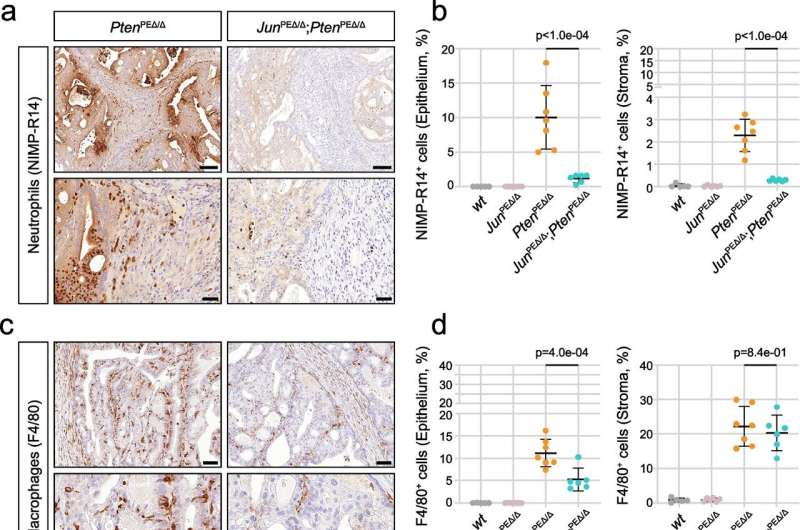This article has been reviewed according to Science X's editorial process and policies. Editors have highlighted the following attributes while ensuring the content's credibility:
fact-checked
peer-reviewed publication
trusted source
proofread
Prostate cancer: Protein identified to reduce tumor growth

As prostate cancer progresses, it becomes increasingly aggressive and can metastasize. In this form, the tumor is difficult to treat, which is reflected in high mortality rates: Worldwide, the malignant disease of the prostate is the second most common cause of cancer death in men.
An international study led by Lukas Kenner and Sabine Lagger has now identified a protein that could slow tumor growth. The results, which have just been published in Molecular Cancer, provide a new starting point for the development of therapies.
The complex molecular processes that lead to the progression of prostate cancer have not yet been fully clarified by science. The protein known as JUN is being intensively researched as a possible driver of tumor growth.
"Numerous studies have shown that JUN is produced excessively in cancer. So, a link has been established between tumor growth and high JUN levels," says Lukas Kenner (Clinical Institute of Laboratory Medicine at MedUni Vienna, Department of Laboratory Animal Pathology at Vetmeduni Vienna).
In collaboration with national and international partners, it was shown that the opposite is the case with prostate cancer: The research team's investigations using a mouse model and clinical samples revealed that the progression of prostate cancer is not accelerated but slowed down when JUN is present in high levels. It was observed that the tumor grows faster when the protein is missing.
The fact that JUN plays an important role in the activation of genes and various processes such as cell growth was discovered back in the 1980s. "In our investigations, we found that JUN is significantly involved in the regulation of prostate cancer by influencing the body's immune response," says Sabine Lagger from the Department of Laboratory Animal Pathology at Vetmeduni Vienna.
If the protein is missing, the recruitment of certain immune cells in the tumor's micro-environment is impaired, which leads to accelerated cancer growth. These results could explain why Prostate cancer is less responsive to immune therapy and could help to understand how to reactivate local immune responses.
Most common cancer in men
Prostate cancer has been the most common cancer in men in Austria for decades. Every year, about 6,000 new cases and 1,300 deaths are registered as a result of prostate cancer. In the vast majority of cases, tumors in the prostate gland remain localized and are therefore easily treatable. However, about 20% of patients develop metastatic prostate cancer, which remains difficult to treat.
"Our research suggests that activating JUN could potentially be a promising therapeutic option for slowing the progression of prostate cancer," state Lagger and Kenner. Further investigations are needed to confirm the results.
More information: Torben Redmer et al, JUN mediates the senescence associated secretory phenotype and immune cell recruitment to prevent prostate cancer progression, Molecular Cancer (2024). DOI: 10.1186/s12943-024-02022-x



















